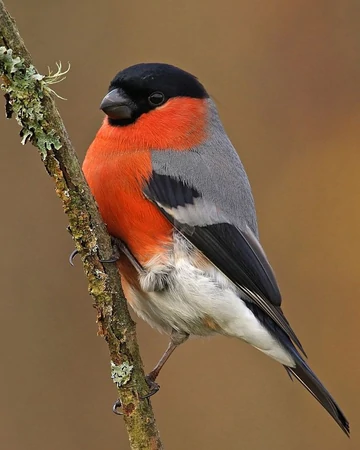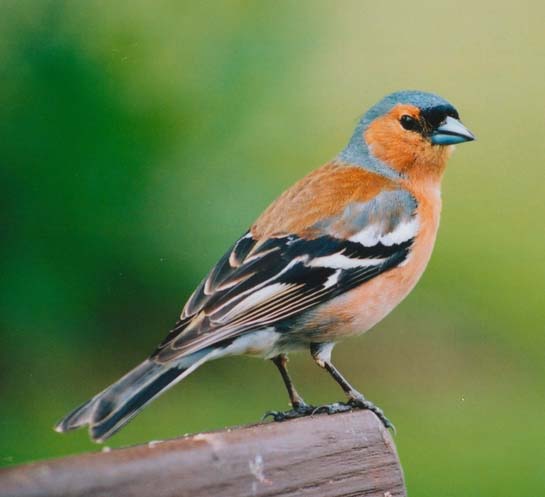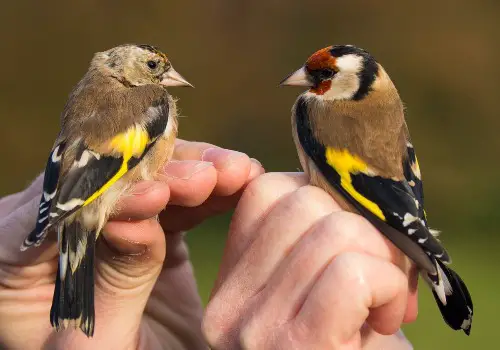Have you seen a chaffinch or bullfinch? Though they both belong to the finch family and inhabit similar habitats, they have slightly different physical features. You'll need to compare these garden birds by their sizes, shapes, and plumages.
These are the highlights of our article. Let's get started!
Main Differences Between Chaffinch Vs Bullfinch
The main differences between bullfinch vs chaffinch are:
- A chaffinch's weight averages 0.6 to 1 ounce, whereas a bullfinch weighs about 0.7 to 0.9 ounces.
- A chaffinch measures 5.7 inches, whereas a bullfinch ranges between 5.7 and 6.5 inches long.
- A chaffinch has a wing to wing length of 10 to 11.2 inches, whereas the wingspan of a bullfinch is 8.6 to 10.2 inches.
- A male chaffinch has a blue-grey crown, whereas a male bullfinch has a black cap.
- A common chaffinch's binomial name is Fringilla coelebs, whereas the other name for a bullfinch is Pyrrhula pyrrhula.
Bullfinch vs Chaffinch: Facts To Differentiate These British Finches
Let's break down the points we've highlighted above to explain the difference between chaffinch and bullfinch species.
Classification
These British finches belong to the Fringillidae finch family, but the chaffinch is in the Fringillinae subfamily, while the bullfinch is in the Carduelinae subfamily together with over 180 species.
Further, the Eurasian bullfinch is in the genus Pyrrhula with other bullfinches like the Azores and the white-cheeked bullfinch, while the chaffinch is in the genus Fringilla with two blue chaffinches and the brambling.
Plumage
Plumage color is the best ID characteristic when differentiating wild birds, but it's not so easy comparing these two species as they have so many subgroups.
The Eurasian bullfinch has ten subspecies found in different parts of the world, from the British Isles to east Siberia and north Japan. That'll guarantee an unforgettable birding tour if you book a trip to see world finches.
The common chaffinch also has several subspecies, but they're in three groups. You can tell them apart by the regions they inhabit.
The spondiogenys inhabit parts of North Africa, the Canary Islands host the canariensis group, and there's a group in Europe and Asia. So, are bullfinches different from chaffinches? Yes, they are.
The first difference you'll see is the color of their crowns. A Eurasian bullfinch is black on the forehead, cap, and eye area. It's almost as if it has a black face. A chaffinch, on the other hand, has a light grey head, and this color doesn't extend under the eyes.


A male Eurasian bullfinch has a pinkish-red chest and a white rump that you'll see as it flies.
The female of this famous cage bird has less flashy plumage as it has grayish buff underparts.
When you compare it with the other small passerine bird, a female chaffinch has a pale olive-brownish back and a grayish-white underside. After molting, a juvenile has the same plumage as an adult female though its wing bars are narrow.
A male chaffinch is colorful but not as striking as the pinkish-red underside of a male bullfinch. It has a blue-gray upper mantle and crown, olive-green rump, and a chestnut-brownish lower mantle.
Wing Bars
Another ID detail to help you tell a chaffinch from a Eurasian bullfinch is on the wings.
When you look at an image of a chaffinch as it flies, you'll see two white wing bars. Now, compare that with a picture of a bullfinch, and you'll note that the wings are black with gray detail.
Bill
A chaffinch's beak resembles an American goldfinch or greenfinch. It's straight, pointed, and conical. Also, it's grayish or dark in color. A bullfinch, on the other hand, has a broader one with an almost round shape towards the tip.
Juveniles
You're likely to mistake juvenile bullfinches for chaffinches as they have brownish to dull brown back like female chaffinches, and they don't have black markings under the eyes.
Song & Call
Though both bullfinch sexes sing, you'll hear the male more, filling the air with a soft teu-teu or peu bullfinch song. It's a different story with chaffinches as only the males sing, and they belt out several tunes. One of those songs sounds like chip-chip-chip, tell-tell-tell.
Body Size
A Eurasian bullfinch is short, stubby, with a round head and a long tail.
It’s different from a common chaffinch which is longer from wing to wing. A bullfinch appears bigger from beak to tail though a chaffinch is heavier.
Diet
Chaffinch is a ground-feeding avian that forages seeds and invertebrates under bird tables. It can crush seeds thanks to its wedge-shaped bill.
A good summer diet comprises insects like caterpillars; therefore, it's easy to draw it to bird feeders with mealworms. Winter brings some diet changes as seeds are more abundant than insects.
A bullfinch has a similar diet of seeds and insects, but it also goes for fruit tree buds in spring.
This is the reason why they aren't welcome in orchards and backyard gardens!
Habitat
Habitat isn't the best way to tell these British finches apart as they sometimes live in the same regions. They both like woodlands, cities, and parks. What's more, they are both backyard visitors that feed side by side.
The chaffinch has a breeding range in northwest Africa, Europe, and Asia.
It's not a migratory species, but it sometimes flies into the eastern area of North America.
Nesting & Breeding
Let's start with chaffinches. For them, breeding starts when a chaffinch turns one, and pairs are monogamous. The breeding season starts earlier in some parts as it depends on the temperature in spring.
Building nests is a one-bird affair for chaffinches as the female takes on the task of joining feathers and roots alone.
A nest hosts about four to five bluish or reddish-gray eggs with purple-brown spots. They hatch in 10 to 16 days, and the nestlings fledge within 18 days.
Bullfinches breed in different habitats, from woods to churchyards and parks. They lay about four to seven eggs and take 14 days to hatch.
Fun Fact: Another interesting bird comparison to research on is the coal tit vs great tit face-off challenge!
Watch This!
Frequently Asked Questions
Are you likely to see a bullfinch or chaffinch?
The UK population of chaffinches is more than bullfinches. Since the UK is one of the main habitats of these finches, it means you're more likely to see a chaffinch. There's a resident population of both species.
Is a chaffinch or bullfinch bigger?
A chaffinch is bigger when you look at its weight and wingspan. However, a bullfinch takes the prize when you're considering its length from the beak to the tail.
Conclusion
As we've found out above, you can tell bullfinches by their shape because a bullfinch has a larger rounded body. Though their plumages are almost similar, the bullfinch has more striking feathers because of its pinkish-red chest and white rump.
Nonetheless, a Fringilla coelebs is more finch-like than a Pyrrhula pyrrhula. We hope you haven't forgotten those two binomial names we mentioned earlier.
Lastly, these birds are wildlife, but they also love backyards. That'll save you the trouble of birding away from home.

